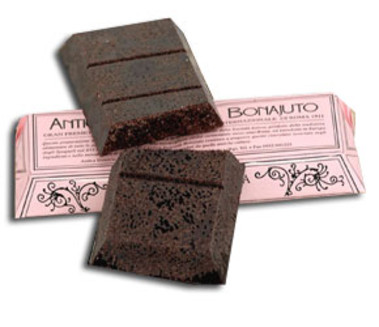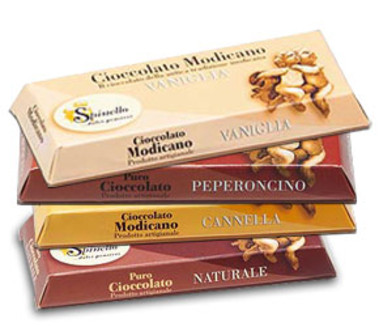Raising the chocolate bar
July 9, 2007 - brandchannel.com


Modican chocolate, a Sicilian favorite whose popularity has been growing exponentially for more than a decade, is a curious point of conversion for the two groups. Heating the cocoa to a relatively very low temperature melts the cocoa butter but leaves the sugar unmelted, forcing you to chew a bit to break it up. Once you do, the heat in your mouth liquefies the sugar and creates a rush of flavors that ranges from the cocoa and cinnamon you might expect to smoky, spicy, or even herbal. It’s enough to give even the most avid chomper pause and leave the daintiest savorer gnawing at the block for another bite.
Here in Modica, however, the purists are worried.
Pierpaolo Ruta’s family has been making what most consider to be the prime example of Modican chocolate (and a damn fine cannoli) at the Antica Dolceria Bonajuto since 1880.
From memory, he cites the legendary Sicilian writer Leonardo Sciascia, whose words have inadvertently served as marketing tools for local chocolatiers ever since he wrote them:
‘‘Modican chocolate is unparalleled in savor, such that tasting it is like reaching the archetype, the absolute, and that chocolate produced elsewhere, however famous, is but an adulteration, a debasement of the original.’’
Just what the archetype is, however, is fast becoming blurry; corruption and debasement may be blooming from within.
“Until 1992, there were only four other producers of Modican chocolate and three of those worked for my grandfather,” says Ruta. “Now there are 40.
“This growth was too fast,” he adds. “Now, I’m worried about quality.”
As if on cue, the phone rings with a Japanese importer on the other end.
“Last week, he called me to say that he had found an all-purpose ‘Modican chocolate’ and he said it was horrible,” he laments. “That’s why I’m worried. If you cook the cocoa wrong, you lose about 380 primary flavors.
“Modican chocolate is like wine. If you make a great wine and cook it for two days [as some industrial chocolate-makers do], you lose everything.”
Enter Dr. Giuseppe Cicero, a sensorial analyst and food-quality controller for the Sicilian government who works to “define” the chocolate above a hardware store in a nondescript office building on the edge of Modica.
“Since [the chocolate] has diverse primary ingredients—different sugars, different cacao—our goal after we complete the studies is to have a standard into which all producers must fit,” he says.
For the studies, Cicero has brought industry pros together every week or two for the past year for chocolate tastings. The group’s findings are helping to build a technical definition of Modica’s singular sweet.
The Devil(‘s Food) Is in the Details
First, drop the notion that the tastings are even vaguely romantic. They can be fun, but it’s challenging work and romantic it isn’t. The group tasting room is harsh white, the light fluorescent, and the only decorations are some land-use maps and drawings of local fruits and vegetables.
Each taster (there are usually about 30) sits in front of seven covered, numbered Dixie cups. Inside each is a lump of chocolate, and next to it all is an intimidating-looking paper where about 25 different characteristics are rated on a scale from 0 to 9. At the end of a class, Cicero might enter some of the tasters’ responses into a complex chart to help educate them and see if any trends are emerging.
“In the future, there will be a standard,” he affirms.
In an environment this aseptic, words like that seem to smack more of science or even corporate lingo than a way to help preserve the quality of an artisanal product.
“Look at Parmigiano-Reggiano [of the famous hard cheese]—it’s been successful because there is a fixed set of rules and procedures,” he says, citing the success of his compatriots to the north, “but the producers have a bit of latitude to personalize their product.”
The standard Cicero, his nibblers and most Modican chocolate producers are working toward is a regional name control called an IGP. Unchecked, name controlling can turn into a wild mess like the one that French wine producers are currently facing, but here, little exists to protect the chocolate. Along with helping define its identity, the IGP would also keep an industrial producer in Rome or a misinformed hippie in Modica from making a granular chocolate and calling it Modican.
“We’re a little late to the game,” admits Cicero.
By researching the product’s roots, chocolate maker Ruta is also doing his part to make sure that his shop has things right. With Sicily under Spanish rule in the 15th and 16th centuries, Modican chocolate’s distant roots lie in Catalonia’s xocolata a la pedra, which, Ruta has found, may have originally been made with Sicilian sugarcane.
“We have to study the history,” says Ruta, hoisting out a large plastic folder bulging with his research, “because now there are people making it who have never tasted the real thing.”
What Is Vanilla?
Learning the real flavor of things, right down to the primary ingredients, turns out to be one of the benefits of tasting with Dr. Cicero. For one recent tasting, he brought a packet of artificial vanilla flavoring and a jar of real vanilla beans. Smelling the artificial stuff first is pleasant, but smelling the real beans afterward completely changes your perspective. The latter has a full, heady aroma that invites you to close your eyes and savor, making a follow-up smell of the artificial stuff harsh and unpleasant.
Ruta contends that after many industrial producers have finished baking all of the flavor out of the cocoa, they dump in fake vanilla to cover it up.
“[At that point,] you have only the texture of the sugar but lose all of the flavors we want to preserve,” he says.
Local food expert Marco Schembari, who runs the food-marketing agency Risorsa Cliente and participates in Cicero’s tastings, agrees with both the importance of a standard and the need for latitude within it.
“If you’re able to make a standard for a product, you can regulate the market relationships with buyers,” he says.
“If I can have a sensorial standard…a producer can say ‘I’ll assure you of these characteristics, but you’ll need to pay X+1, not just X.’ “
It sounds like a fine line between making a cookie-cutter standard and keeping the yahoos out.
“Cicero’s tastings give an opportunity to describe the product,” he counters. “The more instruments you have to describe and profile the product, the better you manage your relationship with your buyer.”
Schembari cites the real and imitation product samples Cicero brings to the tastings as an example of their value.
“When we recognize the fake vanilla flavor in the chocolate, we can go back to the producers and say, ‘This won’t do.’ “
Ergo, putting the real things in there gives both producer and buyer an “X+1” when they sell and the customer gets an “X+1” in the flavor. Good flavors in, bad yahoos out.
Back at Cicero’s office, he’s convinced that the parameters they’re coming up with will be what keeps producers like Ruta, along with buyers and consumers around the world, happier.
” ‘No rules’ means no identity, no terroir and no quality standards,” says Cicero. “Setting the rules is critical for keeping the idea of Modican chocolate alive.”
Joe Ray is a Paris-based food and wine writer. He can be reached via www.joe-ray.com.